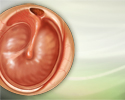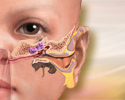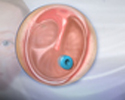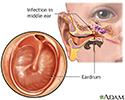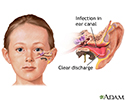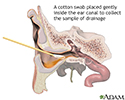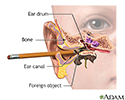Ear infection - chronic
Middle ear infection - chronic; Otitis media - chronic; Chronic otitis media; Chronic ear infectionChronic ear infection is fluid, swelling, or an infection behind the eardrum that does not go away or keeps coming back. It may cause long-term or permanent damage to the ear and involves a hole in the eardrum (perforation) that does not heal.
The Basics
Tests for ear infection
A Closer Look
Ear infection - chronic - Animation
Ear infection - chronic
Animation
Ear infection - acute - Animation
Ear infection - acute
Animation
After your child's ear tube surgery - Animation
After your child's ear tube surgery
Animation
Ear tube insertion - Animation
Ear tube insertion
Animation
Middle ear infection (otitis media)
Otitis media is an inflammation or infection of the middle ear. Acute otitis media (acute ear infection) occurs when there is bacterial or viral infection of the fluid of the middle ear, which causes production of fluid or pus. Chronic otitis media occurs when the eustachian tube becomes blocked repeatedly due to allergies, multiple infections, ear trauma, or swelling of the adenoids.
Middle ear infection (otitis media)
illustration
Middle ear infection
A middle ear infection is also known as otitis media. It is one of the most common of childhood infections. With this illness, the middle ear becomes red, swollen, and inflamed because of bacteria trapped in the eustachian tube.
Middle ear infection
illustration
Swimmer's ear
Swimmer's ear is an infection of the skin lining the ear canal. Bacteria can enter the skin of the ear canal and cause an infection through a scratch, injury from a foreign object, or if the ear is wet for a prolonged period of time. Swimmer's ear is more common in pre-school and school-age children. Symptoms include itching and pain in the ear canal, which is often accompanied by a small amount of clear discharge.
Swimmer's ear
illustration
Mastoiditis - redness and swelling behind ear
Mastoiditis is an infection of the bony air cells in the mastoid bone, located just behind the ear. It is rarely seen today because of the use of antibiotics to treat ear infections. This child has noticeable swelling and redness behind his right ear because of mastoiditis.
Mastoiditis - redness and swelling behind ear
illustration
Ear drainage culture
An ear drainage culture is collected by placing a cotton swab gently in the ear canal. The sample is sent to the laboratory for testing to isolate and identify the type of organism causing the ear infection.
Ear drainage culture
illustration
Foreign object in ear
Children often place objects into their ears that can get stuck in the ear canal. It is important to remove the object since infection is most likely to occur. In most cases, a doctor will need to use special instruments to examine the ear and safely remove the foreign object.
Foreign object in ear
illustration
Ear infection - chronic - Animation
Ear infection - chronic
Animation
Ear infection - acute - Animation
Ear infection - acute
Animation
After your child's ear tube surgery - Animation
After your child's ear tube surgery
Animation
Ear tube insertion - Animation
Ear tube insertion
Animation
Middle ear infection (otitis media)
Otitis media is an inflammation or infection of the middle ear. Acute otitis media (acute ear infection) occurs when there is bacterial or viral infection of the fluid of the middle ear, which causes production of fluid or pus. Chronic otitis media occurs when the eustachian tube becomes blocked repeatedly due to allergies, multiple infections, ear trauma, or swelling of the adenoids.
Middle ear infection (otitis media)
illustration
Middle ear infection
A middle ear infection is also known as otitis media. It is one of the most common of childhood infections. With this illness, the middle ear becomes red, swollen, and inflamed because of bacteria trapped in the eustachian tube.
Middle ear infection
illustration
Swimmer's ear
Swimmer's ear is an infection of the skin lining the ear canal. Bacteria can enter the skin of the ear canal and cause an infection through a scratch, injury from a foreign object, or if the ear is wet for a prolonged period of time. Swimmer's ear is more common in pre-school and school-age children. Symptoms include itching and pain in the ear canal, which is often accompanied by a small amount of clear discharge.
Swimmer's ear
illustration
Mastoiditis - redness and swelling behind ear
Mastoiditis is an infection of the bony air cells in the mastoid bone, located just behind the ear. It is rarely seen today because of the use of antibiotics to treat ear infections. This child has noticeable swelling and redness behind his right ear because of mastoiditis.
Mastoiditis - redness and swelling behind ear
illustration
Ear drainage culture
An ear drainage culture is collected by placing a cotton swab gently in the ear canal. The sample is sent to the laboratory for testing to isolate and identify the type of organism causing the ear infection.
Ear drainage culture
illustration
Foreign object in ear
Children often place objects into their ears that can get stuck in the ear canal. It is important to remove the object since infection is most likely to occur. In most cases, a doctor will need to use special instruments to examine the ear and safely remove the foreign object.
Foreign object in ear
illustration
Ear infection - chronic
Middle ear infection - chronic; Otitis media - chronic; Chronic otitis media; Chronic ear infectionChronic ear infection is fluid, swelling, or an infection behind the eardrum that does not go away or keeps coming back. It may cause long-term or permanent damage to the ear and involves a hole in the eardrum (perforation) that does not heal.
The Basics
Tests for ear infection
A Closer Look
Ear infection - chronic
Middle ear infection - chronic; Otitis media - chronic; Chronic otitis media; Chronic ear infectionChronic ear infection is fluid, swelling, or an infection behind the eardrum that does not go away or keeps coming back. It may cause long-term or permanent damage to the ear and involves a hole in the eardrum (perforation) that does not heal.
The Basics
Tests for ear infection
A Closer Look
Review Date: 1/1/2025
Reviewed By: Charles I. Schwartz, MD, FAAP, Clinical Assistant Professor of Pediatrics, Perelman School of Medicine at the University of Pennsylvania, General Pediatrician at PennCare for Kids, Phoenixville, PA. Also reviewed by David C. Dugdale, MD, Medical Director, Brenda Conaway, Editorial Director, and the A.D.A.M. Editorial team.
